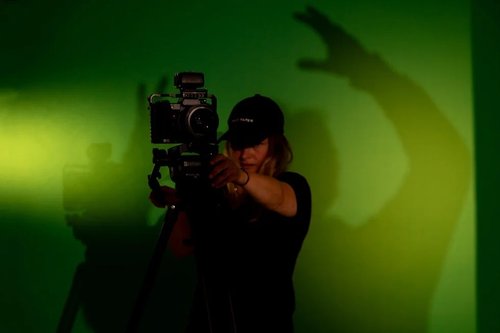Telling your story: How to craft a LinkedIn bio that will stand out to recruiters
13 feb 2024
6 min


Journalist
Everyone loves a good story. When leveraged to its fullest, the LinkedIn ‘About’ section is more than another place to condense professional achievements into bullet points and paste a quick bio—it’s a critical opportunity to tell your story and craft a narrative that will stand out to recruiters. But how is it possible to distill an entire lifetime of personal and professional experiences into one compelling narrative? The answer is, it isn’t. This is all about selecting the right story arc, bolstered by experiences and keywords, that will align with an ultimate end goal.
Crafting your LinkedIn bio requires a lot of preliminary strategizing, goal setting, and technique. This is where the experts come in. We spoke with Anna Vatuone, host of The Personal Branding Podcast and founder of the Personal Brand Accelerator, and Donna Serdula, author of LinkedIn Profile Optimization for Dummies to dig deeper into the art of crafting a LinkedIn bio and the best tips to keep in mind throughout.
First, take a step back and strategize: What do you want to get out of your LinkedIn bio?
Before starting to write your story, Serdula says that it’s critical to take a step back and look at the process from a wider lens. What are you trying to achieve by writing this? Who are you trying to reach? “The very first thing a person needs to do is stop, and don’t write anything at all … stop and strategize,” Serdula says. “Really think to yourself, ‘Why am I on LinkedIn? What am I trying to accomplish, what’s my goal?’ Because your goal is what’s going to determine everything that comes afterward.”
Vatuone similarly says that it’s essential to try to find your ‘why’ before putting pen to paper. “‘Why am I building my personal brand? Why am I optimizing my LinkedIn profile? Why am I choosing to write this story?’ Once you know why, and the deeper mission and purpose behind why you’re building your personal brand, then you can decide what story you want to tell,” she explains. “So if your why is to build your personal brand for a new job, and you want to get employed at your dream company, what is the story from your life that coincides with why you would be the perfect person to work at that company? How can you show people through a story, instead of just telling them why you’re great?”
Serdula says that it’s critical to do this preliminary thinking upfront to avoid a misalignment between what you’re putting down and who’s picking it up. For example, a salesperson who is trying to reach prospects shouldn’t copy-paste their resume into the About section—this wouldn’t attract who they’re looking for. There should be constant updating, reiterating, repositioning, and realigning of the profile as goals evolve and change, according to Serdula.
Next, use your ‘why’ to identify some keywords to plug into your LinkedIn bio
Now you know why you’re writing the About section and what you’re trying to achieve with it. Let’s say you’re trying to land a position at your dream job: the next step is identifying an array of keywords to use throughout your story. Not only will this make you easier to find by search, but it will help to shape your story and attract the attention that you want.
If a company has the keyword ‘trust’ in its mission statement for example, Vatuone advises using that keyword “as a jumping-off point to think and write about the story that displays and highlights how you learned to trust in your life, or a time when you could trust someone, or when you trusted someone and maybe it wasn’t the best decision after all— what did you learn from that?” She explains that keywords are the most important thing when writing your LinkedIn bio. “Look for the keywords, look for the commonalities, and write a story that feels real and feels genuine to you, while also speaking to that company’s message.”
Once you’ve done your homework—identifying your dream company, looking at its values, and identifying some keywords—Vatuone says your story should then align with those values, and explain how you’ve come to where you are today.
Another way to look at it is by putting yourself in the shoes of the person that you want to find you. What keywords would they plug into the search bar that would make you pop up? “If a person doesn’t know I exist, what words would they put into the LinkedIn search to find me? Those keywords are the words that you want to make sure that you inject into your content,” Serdula says.
After identifying your keywords—and potentially using them to hone in on your story and narrative—it’s important to use them throughout the narrative in a contextual sense, avoiding the bullet-point format you’d see on a resume, Serdula advises.
Being authentic, honest, and personable will make a better story
One of the biggest challenges in crafting a LinkedIn bio is digging into a lifetime of experiences and pulling out the one cohesive narrative that will best highlight what you’re trying to put forward. “How do you condense your whole life story into a story? You pick one story. And you pick the story that is the most pertinent, the most important, the most impactful for you, and you tell that story,” Vatuone says. “It’s less about what’s important to everyone else and what you think people want to hear, and it’s more about telling the story that you want to share—that’s the key here.”
This plays into the notion of authenticity, something that has become somewhat of a buzzword in the age of influencers and AI. But Vatuone argues there are some misconceptions about what it means, at least in terms of the LinkedIn bio. It’s not sharing “your deepest darkest secrets” necessarily, but more about being genuine about what you choose to put out there, and being real with people.
“It’s far more interesting to read someone’s real, direct account and story of their experiences instead of just a highlight reel, [or] few bullet points that tell me your career achievements, because that really doesn’t mean anything to anyone unless we know the story behind it,” Vatuone explains. “So the sweet spot is to have both—to tell the story, and to list those career achievements, and tell people what you’ve done.”
There’s also an element of this that plays into what not to do—don’t inflate, don’t exaggerate your achievements, and keep it real, Vatuone adds. While it’s important to put forward credentials, what’s more compelling is to tell an engaging story. What were you before, what happened, and who are you now? That’s what people want to know.
This has become even more important in the age of AI. “Obnoxiousness may get you through the algorithm, past AI, but it will never get you past the human eye,” Serdula shares. “Personality, warmth, a conversational aspect … I love [it] when a person’s profile truly is about them, and they open up, and they give you a glimpse into who they are, what they do, why they do it, why it matters, what they stand for … These are important things, especially in this watershed moment that we’re at with AI.”
Breaking down the LinkedIn About section into a structure
Serdula breaks down the LinkedIn About section structure into three key components.
- Use a hook: The first sentence should be eye-catching. When someone initially looks at the About section, only the first sentence is displayed, so you have to click on ‘see more’ to expand it. The hook should include who you are, what you do, how you help, and why it matters, and should make people want to read more.
- Include a call to action: The end of the About section should really include a call to action that directs people to where you want them to go. It could be a website, an email address, or a phone number.
- Don’t be afraid to write a lot: It’s better to go longer than shorter because this creates more room to include keywords that will lead to meaningful connections. The sweet spot is about 2500 characters with spaces.
Be confident, and don’t hold back on the LinkedIn About section
It’s common to find it hard to write about yourself. But Serdula argues that this is the section to put it all out there. If a person’s reading it, they want to learn more, so why hold back?
Similarly, Vatuone has some advice to keep in mind throughout the writing process. “Your competitive advantage is you,” she says. The people who are unafraid to be themselves stand out. It takes someone who is willing to be criticized, accept feedback, and sometimes be uncomfortable, but honesty makes people pay attention.
“That’s the competitive advantage—to share who you are,” Vatuone says.
Photo: Welcome to the Jungle
Follow Welcome to the Jungle on Facebook, LinkedIn, and Instagram, and subscribe to our newsletter to get our latest articles every week!

Más inspiración: Networking para encontrar trabajo

Messaging recruiters: 7 mistakes to avoid on LinkedIn
Think messaging a recruiter on LinkedIn guarantees an interview? Not if you make these mistakes. Here's how to get noticed for the right reasons.
02 dic 2024

From tech to television: the benefits of alumni networking
Using your alumni network can be a game-changer for your career, allowing you to connect with people who share your background and experiences.
30 jul 2024

How to network in tech with no experience
Networking can be daunting for anyone, but entry-level tech workers have a unique challenge ahead.
30 may 2024

Make your mark: How to build a personal brand for the job hunt
What’s the secret to success in today’s job market? None other than personal branding.
22 abr 2024

Messaging recruiters on LinkedIn: Should you go for it?
Your ultimate guide to strategically sliding into a recruiter’s DMs … without being annoying.
31 ene 2024

¿Estás buscando tu próxima oportunidad laboral?
Más de 200.000 candidatos han encontrado trabajo en Welcome to the Jungle
Explorar ofertas